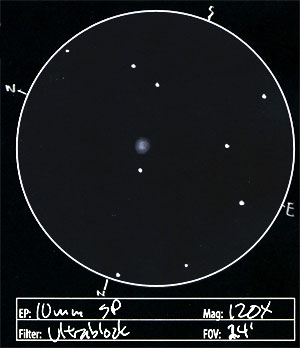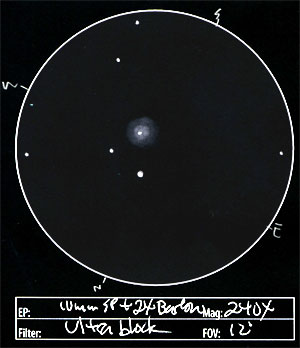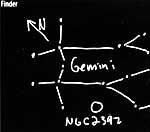

Observation Notes:
 What an unbelievable planetary nebula. It was very bright and detailed. It rested about 2′ south-southwest of a bright star. It was circular, and had a brighter circle within. This inner circle hinted at more detail. So I bumped the magnification up from 120X to 240X, and it did very well. The central circle was mottled and perhaps roughly triangular in shape. After removing the Ultrablock filter, a central star appeared. It seemed like the star may be a bit north of center. I didn’t realize this was the Eskimo Nebula until after the observation and I was double-checking a reference in the Bright Star Atlas. It’s a beaty, that’s for sure. I cought it just as dawn twilight was brightening in the east. It was a great way to end the night’s observations.
What an unbelievable planetary nebula. It was very bright and detailed. It rested about 2′ south-southwest of a bright star. It was circular, and had a brighter circle within. This inner circle hinted at more detail. So I bumped the magnification up from 120X to 240X, and it did very well. The central circle was mottled and perhaps roughly triangular in shape. After removing the Ultrablock filter, a central star appeared. It seemed like the star may be a bit north of center. I didn’t realize this was the Eskimo Nebula until after the observation and I was double-checking a reference in the Bright Star Atlas. It’s a beaty, that’s for sure. I cought it just as dawn twilight was brightening in the east. It was a great way to end the night’s observations.
Factoids:
The double-shell morphology of NGC 2392 helps contribute to it’s entrancing appearance. The nebula’s visual magnitude is 9.1, and it’s central star, HD 59088, has a visual magnitude of 10.5. The distance is not well known, but has been estimated at 3000 light years. It was discovered by William Herschel in 1787.
| Subject | NGC 2392 – The Eskima Nebula/Clown Nebula |
| Classification | Planetary Nebula |
| Position* | Gemini [RA: 07:29:12 / Dec: +20:55:00] |
| Size* | 0.7′ |
| Brightness* | 9.1 |
| Date/Time | October 1, 2005 – 5:15 AM (October 1, 2005 – 12:15 UT) |
| Observing Loc. | Cinder Hills Overlook, Sunset Crater National Monument, AZ |
| Instrument | Orion SVP 6LT Reflector (150 mm dia./1200 mm F/L) |
| Eyepieces/Mag. | 10 mm (120X), 10 mm + 2X Barlow (240X) + Ultrablock |
| Conditions | Clear, calm, 48�F |
| Seeing | 2-3/10 Pickering |
| Transparency | Mag 5.2 NELM (based on Ursa Minor) |
| Sources | SEDS NOAO |
*Based on published data.